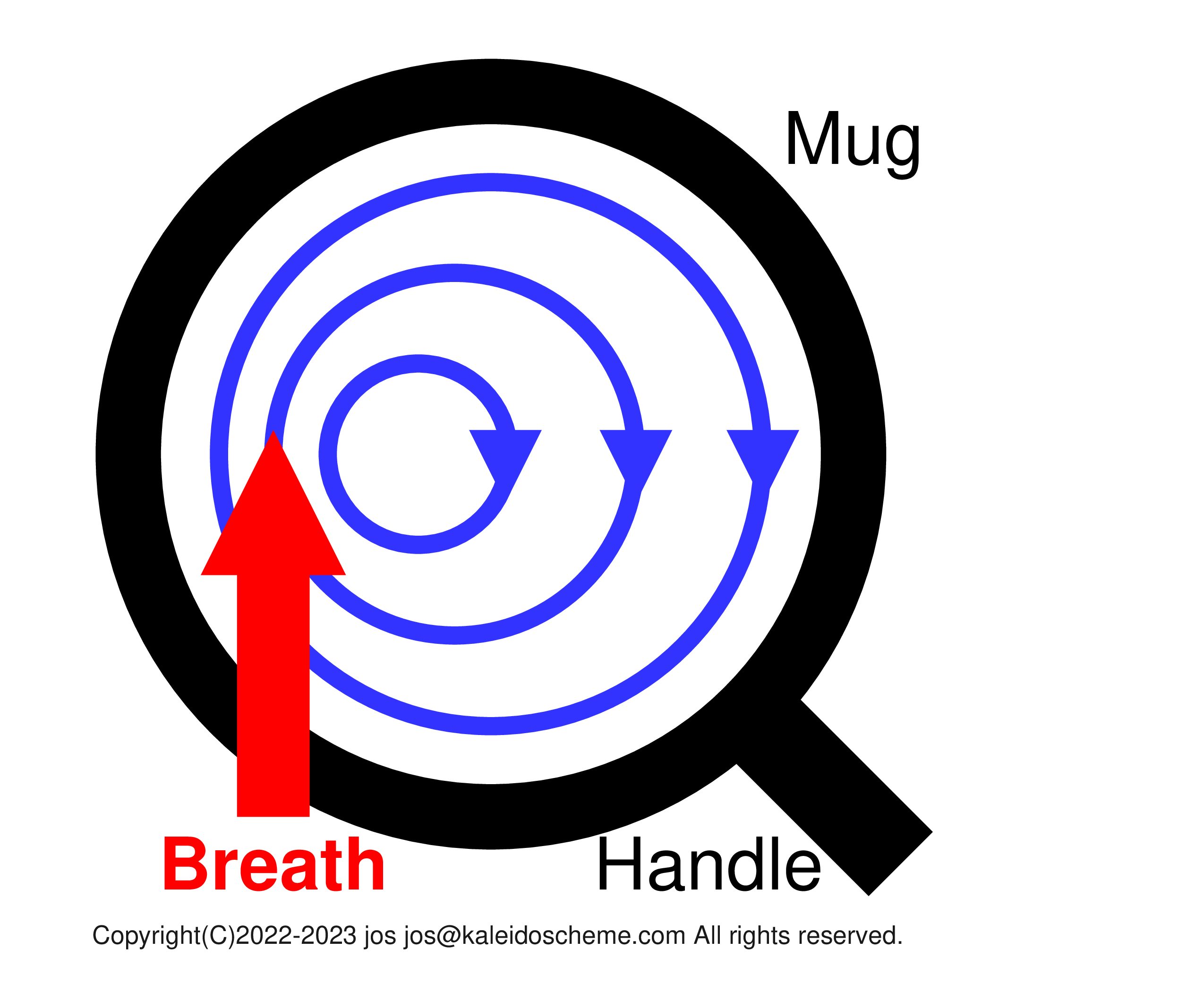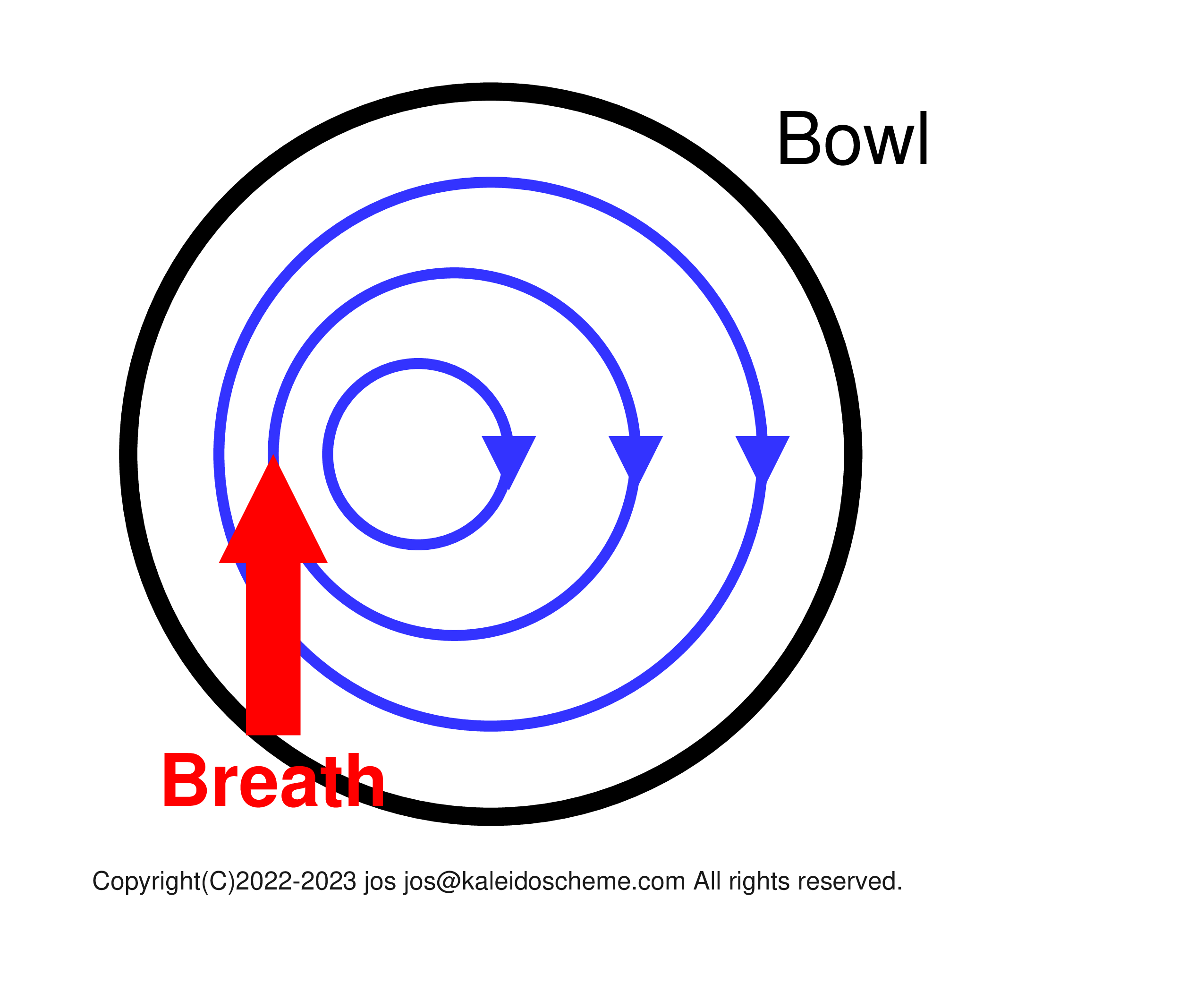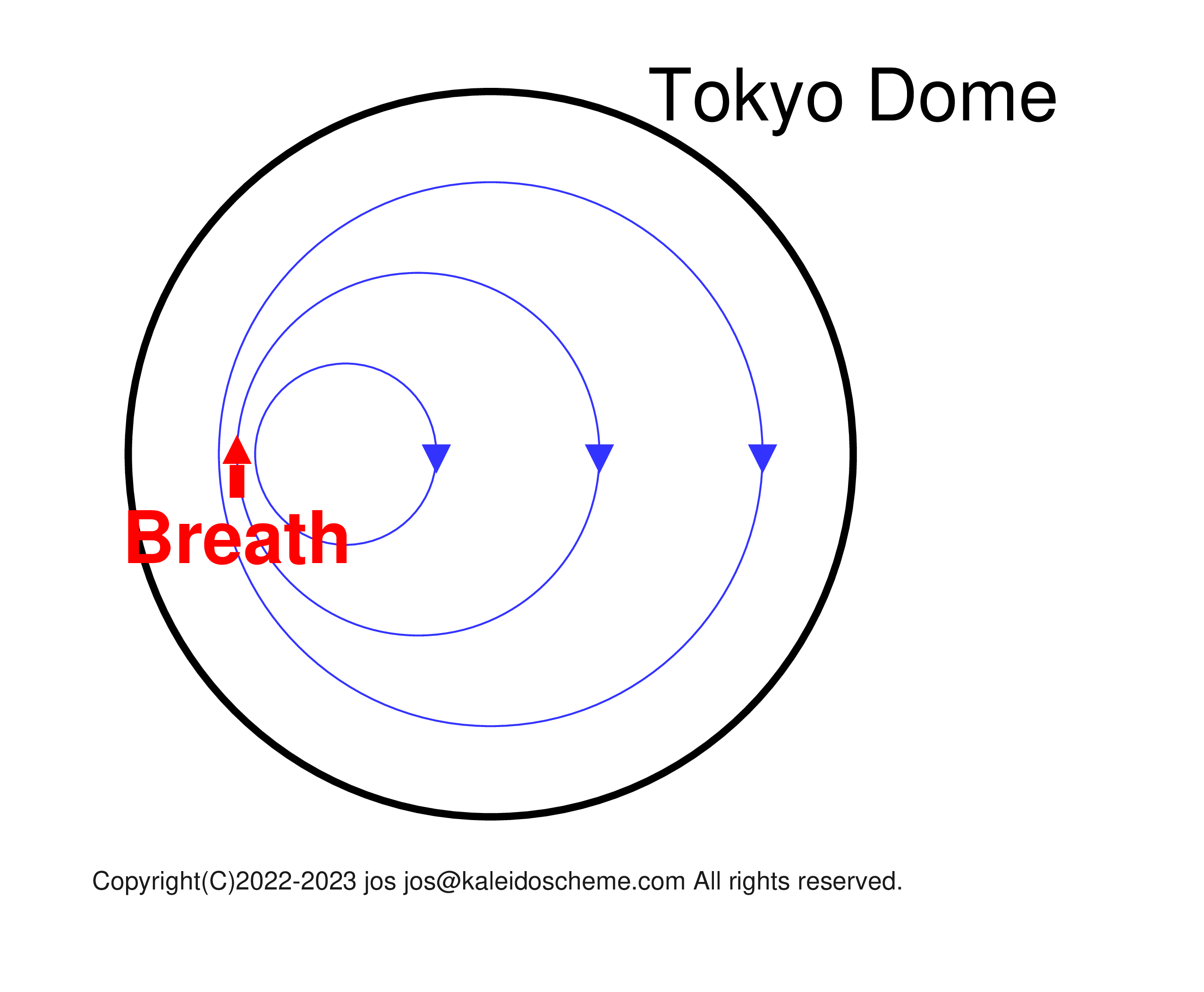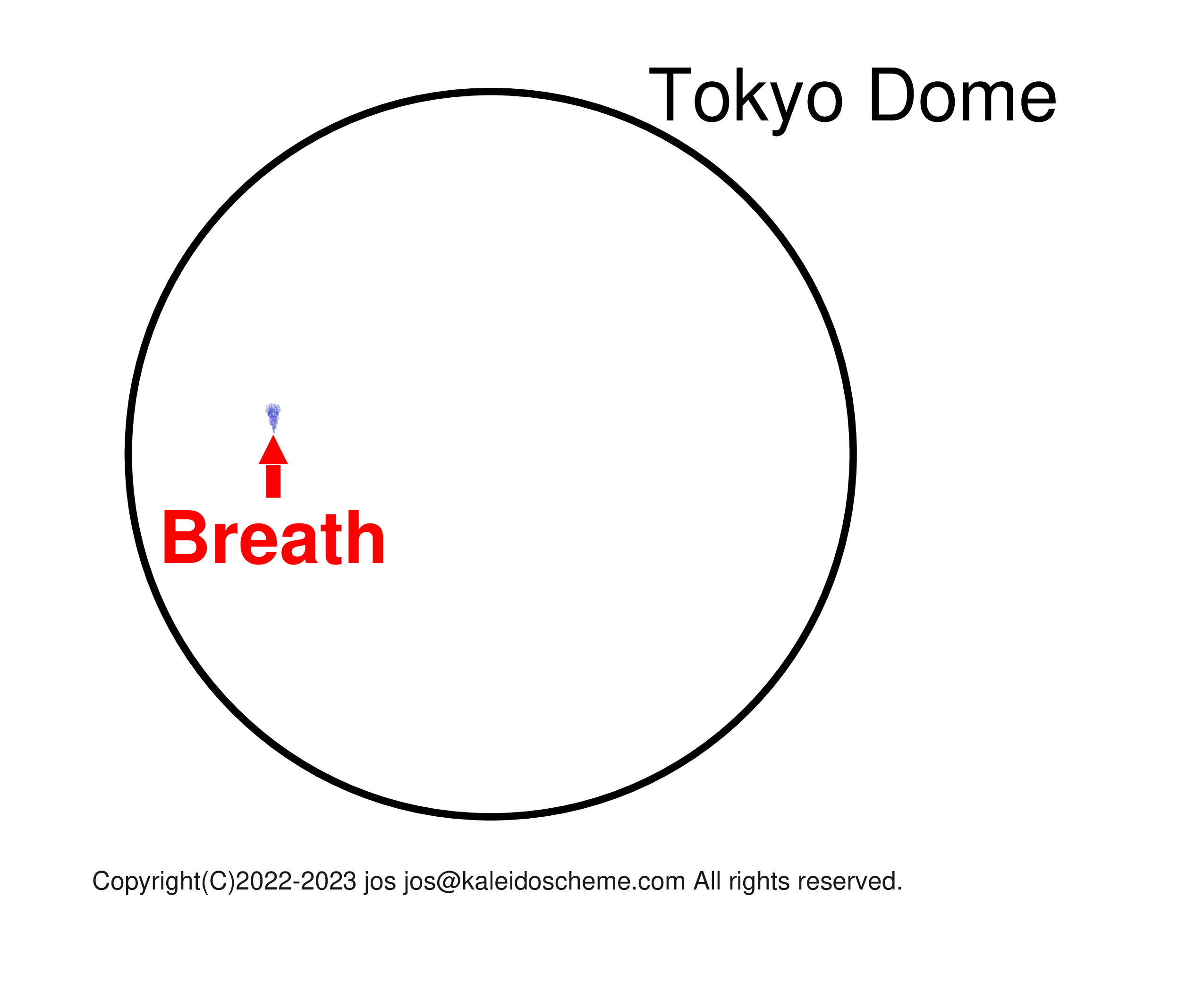
Mug, Bowl, and Tokyo Dome < rdctheory.cloud

Do you have a mug? Try blowing gently inside the mug toward an off-center position (as the red arrow in Fig. MBT-1). Blow for one second, rest for ten seconds, and repeat. When you blow a breath, you will recognize a circular flow along the inside of the mug (as shown with the blue lines and arrows), though you cannot see it. If you want to visualize the flow, a very small amount of powdered throat medicine inside would be a good tracer. It's an easy experiment, and you get the idea, right?
You don't have to actually do the experiment set shown here. Rather, imagine the results in your mind. They are often called "thought experiments". But take it easy, they are simply to imagine.

Do you have a bowl? Try blowing gently inside the bowl toward an off-center position (as the red arrow in Fig. MBT-2). Blow for one second, rest for ten seconds, and repeat. When you blow a breath, you will see a circular flow along the inside of the bowl (as shown with the blue lines and arrows). However, the bowl is larger than the mug, so the strength of the flow will be a little weaker (The weakened flow is represented by the thinner lines and smaller arrows). It's an easy experiment, and you get the idea, right?

Have you ever been in Tokyo Dome? Unfortunately, I have not. Tokyo Dome is a big baseball stadium, but it is also used for various entertainment events.
[NOTE]
Tokyo Dome has become even more famous as the venue for the first round POOL B games
and the quarter-final
of the 2023 WBC (World Baseball Classic).
Every game was exciting and every team were fantastic!
By the way, try blowing gently inside Tokyo Dome, at an off-center position (as the red arrow in Fig. MBT-3. The shape of Tokyo Dome is shown here as a circle, although the actual shape is somewhat distorted. It does not affect the result). Blow for one second, rest for ten seconds, and repeat. When you blow a breath, you will see a circular flow along the inside of Tokyo Dome (as shown with the blue lines and arrows). However, Tokyo Dome is much larger than a mug, so the strength of the flow will be much weaker (The very weak flow is represented by the very thin lines and very small arrows). Only a very sensitive flow monitor could detect the circular flow. It's an easy experiment, and you get the idea, right? ...
Hey! Wait!
NO WAY!
NO KIDDING!
NO! NO! NO! NO! NO!

Blowing inside Tokyo Dome will NEVER create a flow that extends over the entire dome. Even the most sensitive monitor on the other side in the dome will not be able to detect a flow, because THERE IS NO FLOW. Your breath will immediately become turbulent and stir the air in front of you (as shown with the fine blue lines in Fig. MBT-4). Even if you blow harder, it only stirs the air more strongly. This is what makes air a nonlinear medium.
In the case of the mug and the bowl, the physical scale (the spatial scale and time scale) of the air motion matches the physical scale of the flow of the blown breath (a few centimeters width and one second duration). This is how the flow is efficiently created. However, the physical scale of the air motion inside Tokyo Dome (a few hundred meters width) is much larger than the physical scale of the flow of a human breath. This makes it impossible to create an effective flow field.
We used Tokyo Dome as an extreme example, but if you did the same thing in the room you are in now, the result would be the same, only if your room is larger than one meter cube. Your breath will only stir the air in front of you. Roughly speaking, air with a physical scale larger than ten times the scale of your breath would be difficult to blow and move any longer.
The examples given here are not new discoveries, but facts that have been known for a long time. They are summarized as the second law of thermodynamics. Natural flows that start out on a large physical scale transition to flows on a smaller physical scale, and eventually turn into heat, which is a random molecular motion. The peak of the energy spectrum transitions from a phenomenon with a large wavelength to one with a small wavelength, never in the opposite direction. This law breaks the perpetual motion delusion into which we are always likely to fall. If your breath were to move the air inside Tokyo Dome, it would violate the second law of thermodynamics, which makes it a thermodynamically impossible phenomenon.
If you want to create a flow of air in a huge space like Tokyo Dome, the following methods are possible:
[NOTE]
Another example is the screw of a tanker.
Have you ever seen a huge screw attached to a huge tanker at a dock?
To an environmentally conscious person, such a huge screw looks inefficient.
Since there are plenty of smaller, more efficient motors available,
why not install many smaller, energy-efficient screws, each driven intermittently,
to propel the ship using less energy?
Unfortunately, this new idea does not work.
As shown in the Tokyo Dome example above,
moving air on a large scale required a drive system of similar size.
Similarly, to propel a ship,
it is necessary to push the water surrounding the ship backward.
Trying to do this on small spatial scales and short time scales is impossible.
Small physical scale flows are immediately converted into smaller eddies
and become turbulent.
To propel a ship, it is necessary to create a flow of the same magnitude as the ship.
Furthermore,
it is more efficient to create a steady flow
in order to avoid creating turbulence in front of the forced flow each time.
For these reasons,
huge tankers are also equipped with huge screws,
which are driven steadily to generate propulsion.
We are not actually interested in creating air circulation inside Tokyo Dome or in propelling tankers. These examples are presented to make you aware of the similarity breaking of nonlinear fields for different physical scales and the difficulty of small-scale flow making large-scale flow. What we want you to understand is that Dynamical Detrainment, which attempts to transport mass, heat, and water vapor by blowing from cumulus clouds, is just like breathing hard inside Tokyo Dome. Isolated cumulus clouds that develop at low latitudes are spaced tens to hundreds of kilometers apart and between long (much longer than an hour) time intervals. Whereas cumulus clouds have a diameter of a few kilometers and a duration of one hour. Looking closer, a cumulus cloud is a domain in which the mixing motion of the lower and upper atmosphere is taking place, so the actual flow within the cumulus has only the physical scale of the motion of the bumps appearing on the cloud surface. As mentioned above, such a small physical scale flow does not create a large flow. Efficient transport within a large clear-sky area will not be possible by any kind of Dynamical Detrainment. Even if it could be done in a numerical model, it would not actually occur in nature and, of course, would not give the correct feedbacks in a warming situation. Certainly, cumulus dynamics has made a significant contribution to meteorology. However, it cannot go beyond the scope of weather forecasting on the scale of cumulus clouds directly involved. For climate prediction involving large physical scales, it is necessary to have a completely different perspective.
On the other hand, Radiatively Driven Circulation (RDC) can ensure efficient transport from the interior to the exterior of the cumulus. RDC is driven by radiative cooling over the clear-sky region outside the cumulus. In other words, RDC is a circulation determined by the large spatial scale of the wide clear-sky region and the large time scale of radiative cooling over a long period of time. Furthermore, the mechanism of RDC is not the blowing out of cumulus clouds, but the sucking by the mass divergence involved in the subsidence flow field. Thus, RDC fulfills all the items 1., 2., and 3. on the above list of conditions for creating circulation in the large air. Why don't you try the RDC scheme?
Mug, Bowl, and Tokyo Dome < rdctheory.cloud
Exhibited on 2023/01/16
Last updated on 2025/09/15
Copyright(C)2022-2024 jos <jos@kaleidoscheme.com> All rights reserved.